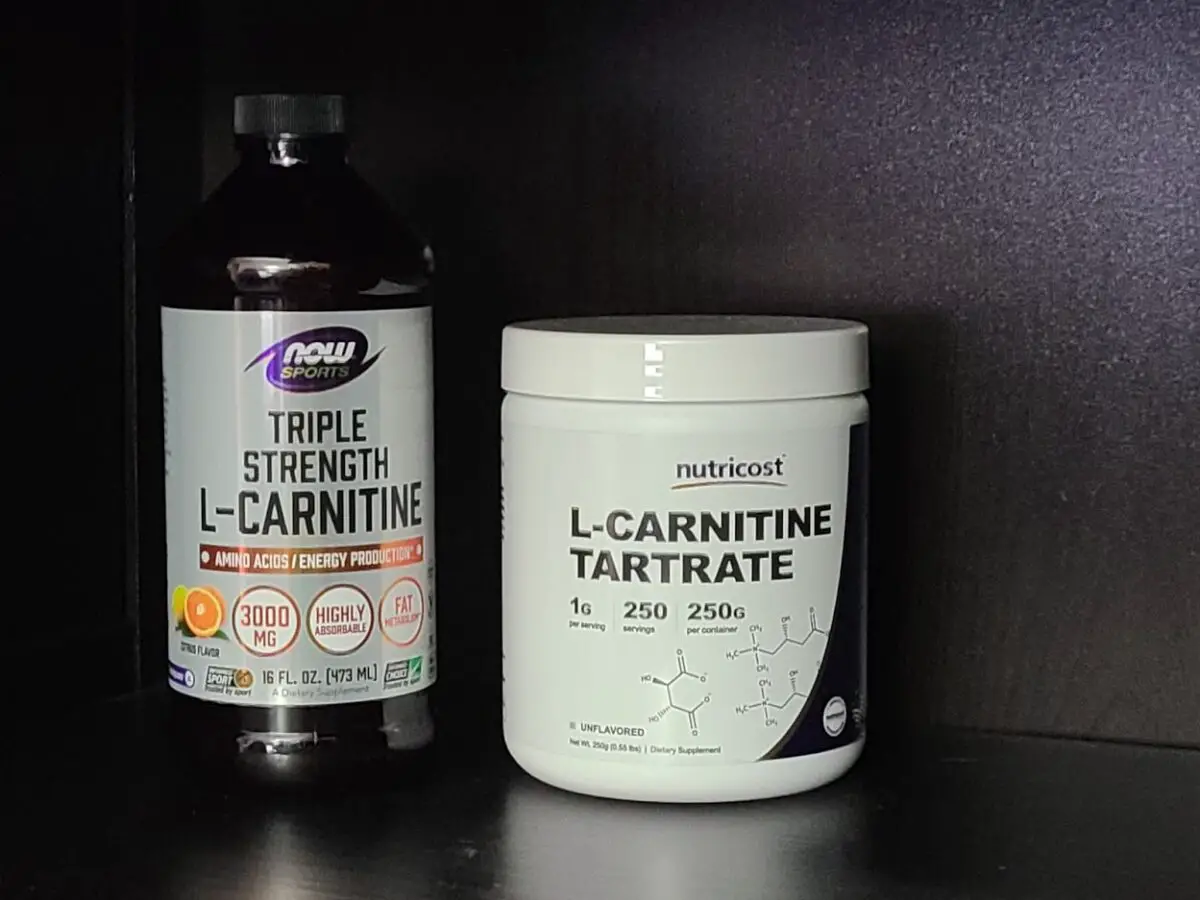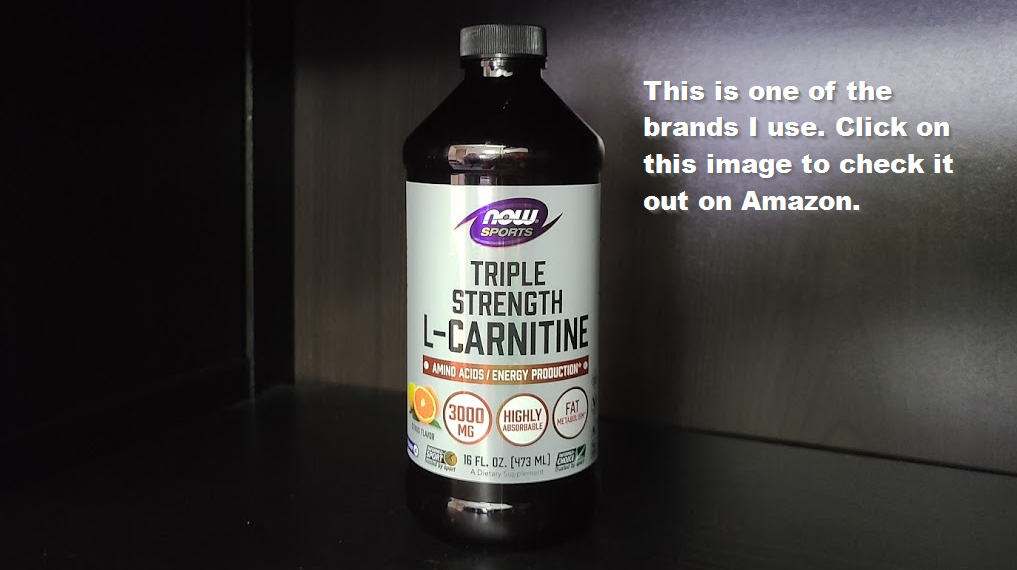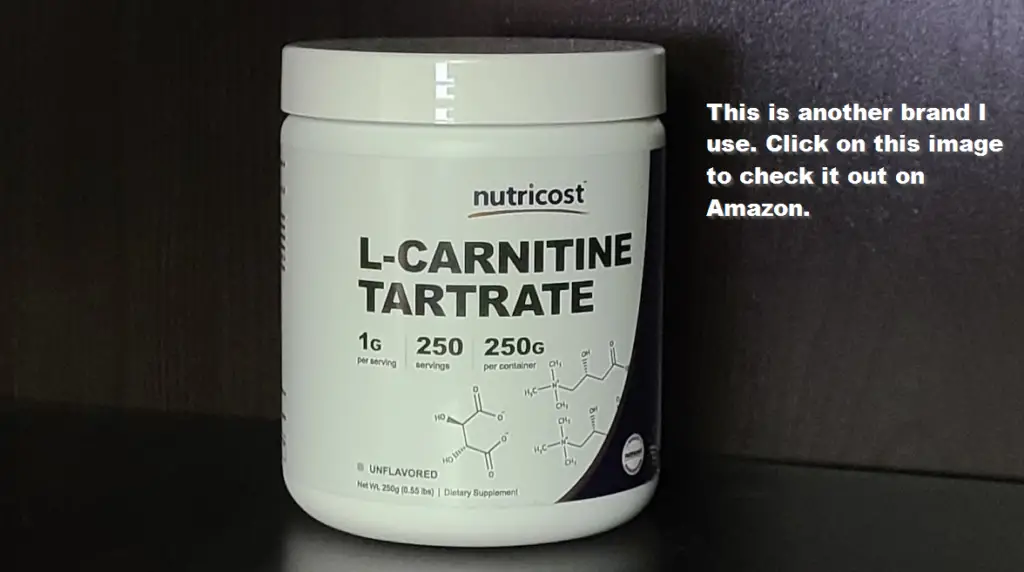L-carnitine didn’t receive much attention in the past, and people mostly discarded it. But these days, the ingredient is finding its way into more and more supplements on the market.
If you haven’t heard of l-carnitine before, this is a potent supplement that appears to deliver numerous benefits, including better muscle growth, fat loss, improved athletic and cognitive performance, and faster post-training recovery.
But then, on the other hand, we also have many naysayers who suggest that l-carnitine is nothing more than a waste of money.
But, who is right and who is wrong here? In this guide, we’ll break it down for you. By the end, you’ll know everything there is to know about this supplement.

What Is L-Carnitine And What Are Its Functions Within The Body?
L-carnitine is a naturally-occurring nonessential amino acid commonly found in meat, poultry, fish, and dairy.
The amino acid is considered nonessential (or conditionally-essential) because the body can produce it, so long as we get enough of two other amino acids – methionine and lysine. The body mostly stores l-carnitine in our muscles, which isn’t a big surprise, seeing as its primary benefits concern physical performance (1).
The primary functions of carnitine within the body have to do with energy metabolism. More specifically, carnitine appears to be vital for fat mobilization and beta-oxidation. Carnitine takes long chains of fatty acids into the mitochondria to be broken down for energy (2). In other words, carnitine allows the body to use more fat for fuel instead of carbs and protein.
It also takes metabolic by-products away from the body and prevents their accumulation.
Now, in case you’re wondering, “L”-carnitine is one of two forms – the other is D-carnitine. The main difference is, L-carnitine is naturally-occurring, while D-carnitine is toxic and inhibits the work of its “L” brother (3). Because of that, supplements only contain l-carnitine in one of its four common forms:
L-Carnitine
This is the naturally-occurring form of carnitine within the body, and it is also the most common form found in different supplements.
L-Carnitine L-Tartrate (LCLT)
L-carnitine L-tartrate is a form of carnitine bound to tartaric acid (which naturally occurs within many fruits) for better absorption. This is the most common type of carnitine used in most studies.
Acetyl-L-Carnitine
Acetyl-L-carnitine, also known as acetylcarnitine, is also naturally produced within the body. This is achieved through a process known as acetylation, where an acetyl group is introduced into a chemical compound. In the case of carnitine, it looks like this:
acetyl-CoA + carnitine ⇌ CoA + acetylcarnitine (4)
Glycine Propionyl L-Carnitine (GPLC)
And lastly, we have GPCL. This form of carnitine is bound to the amino acid glycine and appears to offer greater antioxidant properties (5). This form of carnitine also shows promise in the face of nitric oxide boost and improved blood flow (6, 7).
Today, we are focusing on the benefits of L-Carnitine & L-Carnitine L-Tartrate (LCLT) which can be used interchangeably.

Why Do People Supplement With L-Carnitine?
Much like with creatine, people supplement with l-carnitine with one primary purpose in mind:
To increase carnitine levels in the body, mostly within the muscles. This is linked to several exciting benefits, including decreased muscle soreness (8). Interestingly enough, carnitine supplementation (particularly l-carnitine l-tartrate) appears to speed up the process of muscle repair. In the words of the researchers:
Two grams of l-carnitine supplementation had positive effects and significantly (P < or = .05) attenuated biochemical markers of purine metabolism (ie, hypoxanthine, xanthine oxidase), free radical formation (malondialdehyde), muscle tissue disruption (myoglobin, creatine kinase), and muscle soreness after physical exertion.
Another study also found that l-carnitine l-tartrate supplementation favorably affects post-training recovery (9). What’s more, carnitine might offer further benefits relating to exercise performance, as it appears to increase nitric oxide levels and blood flow (6, 7, 10).
“Okay, but what about fat loss?” I hear you thinking.
The primary reason people supplement with l-carnitine is to increase fat loss. According to some studies, increasing our muscle carnitine levels through supplementation causes the body to use more fat as fuel and reduces the use of carbs. This allows our muscles to maintain their glycogen levels better and boosts the rates of fat release and oxidation. This most likely has to do with one of carnitine’s primary mechanisms:
To take long chains of fatty acids into the mitochondria to be broken down for energy (2).
In one paper from 2011, researchers examined some of the mechanisms behind energy production and how carnitine fits into the whole picture (11). In their words:
1) Carnitine has a crucial role in lipid oxidation by mediating the translocation of long-chained fatty acids into mitochondria.
2) In this work, they have not only shown increased muscle carnitine but also that this alters muscle metabolism during exercise. Firstly, during low-intensity exercise (50% ) carnitine supplementation resulted in reduced glycogen utilization and reduced activity of the pyruvate dehydrogenase complex (PDC). PDC is a main control point of CHO oxidation and has a complex mode of control including feedback inhibition by the products acetyl-CoA and NADH.
3) The carnitine-induced sparing of muscle glycogen is an important finding and is consistent with an increased lipid oxidation.
In other words, higher muscle carnitine levels appear to help with glycogen loading and fat oxidation, while inhibiting carb oxidation.
Here is a related video from Thomas DeLauer. Seems to be all good info.
An interesting limitation of carnitine supplementation is that we can’t reliably increase carnitine levels within our muscles – at least not in the short term. In the same paper, researchers suggested:
Three months of dietary supplementation with a combination of carnitine and CHO had no effect, but after 6 months muscle carnitine content increased by 21%.
The researchers also suggest that one reason why some of the carnitine literature isn’t conclusive is precisely because of this fact:
The necessity of using a very long supplementation period demonstrates the difficulties involved and explains the failure of previous studies with shorter intervention periods.
On the one hand, this is a bit disheartening because it means that we might have to supplement with carnitine for a long time before reliably increasing our muscle carnitine stores. On the other hand, however, this sounds quite promising as it shed some light on previous carnitine literature and gives us a potential explanation as to why some of the studies failed.
For example, in one study, twelve subjects were split into two groups (12):
- A control group that was given 80 grams of carbs twice daily
- A group that took 1.36 grams of carnitine with 80 grams of carbs twice daily
All subjects did thirty minutes of exercise at 50 percent of maximal oxygen consumption once before and once after the supplementation and carb consumption.
After twelve weeks, measures of carnitine palmitoyltransferase 1 remained similar in both groups (13). But, the carnitine saw the following improvements by the end of the trial:
- Muscle total carnitine levels increased by 20 percent
- Long-chain acyl-CoA increased by 200 percent
- Whole-body energy expenditure increase by 6 percent
What’s more, the control group saw a gain of 1.8 kilos (roughly four pounds) of fat mass during the trial, where the carnitine group did not.
Another interesting finding in that study was that 73 out of 187 genes related to fuel metabolism were upregulated in the carnitine group. The researchers also stated that insulin stimulates the transportation of carnitine to our muscles, which makes sense. After all, insulin is vital for nutrient absorption.
As far as the fat gain is concerned, the researchers suggest that the carnitine group didn’t gain weight thanks to two direct effects of carnitine:
- The increase in energy expenditure;
- The raised fat oxidation rates during low-intensity exercise;
Their concluding statement is as follows:
In conclusion, increasing muscle total carnitine in healthy humans can modulate muscle metabolism, energy expenditure and body composition over a prolonged period, which is entirely consistent with a carnitine-mediated increase in muscle long-chain acyl-group translocation via CPT1.
Further Reading on Pump Some Iron: If you are dieting/ looking to lose fat, you may interested in this article about wearing a weighted vest while dieting. Click this link to check it out.
How to Take L-Carnitine
Okay, the above findings are all well and good. But what does all of this mean for us?
For one, it means that merely consuming carnitine probably won’t cut it. Having excessive amounts of carnitine in our bloodstream doesn’t mean that our muscle carnitine levels will increase, nor does it mean that we’ll reap any potential benefits. This is because a normal healthy person isn’t deficient in circulating carnitine levels. The problem is, the transporting mechanism is saturated and can only shuttle so much carnitine.
Think of it like this:
If you have 100 tons of cement and only two trucks to move it from point A to point B, your problem isn’t with the quantity of cement – it’s the lack of transporting vehicles that trips you up. So, instead of trying to fix the issue by acquiring more cement, invest in more trucks.
So, loading higher doses of carnitine won’t do much for us unless we also improve our transporting capacity. Several studies have failed to reliably increase skeletal muscle carnitine levels, both through oral administration and intravenously. This is not because the subjects lacked circulating carnitine – they lacked the means of transporting it to their muscle cells.
From what we’ve seen in the research so far, we should supplement l-carnitine with carbs (14):
For fat loss, l-carnitine should be taken at the same time as consuming carbohydrates. Research shows that 60-100g of carbohydrates, along with 2g of l-carnitine is an effective method. The consumed carbohydrates increase insulin levels and insulin is responsible for shuttling l-carnitine into muscle cells.
Further Reading on Pump Some Iron: After this article on carnitine, you should read this article about Carb Backloading. They kind of go hand in hand. Click this link to check it out.
Hypercarnitinemia in the presence of a fasting insulin concentration had no effect on either of these parameters. This study demonstrates that insulin can acutely increase muscle TC content in humans during hypercarnitinemia, which is associated with an increase in OCTN2 transcription.
That way, we can take advantage of insulin mechanisms and allow for greater muscle carnitine saturation. Carbs cause a rise in insulin, and the hormone then shuttles nutrients into our muscle cells. In the study we saw above, subjects took 1.36 grams of carnitine with 80 grams of carbs twice per day (12).
You may not need to take that many carbs with your carnitine dose, given the fact that even a smaller intake will cause a rise in insulin levels. Still, until we have more research on that, we can’t say for sure. In the above study, researchers saw that peak serum insulin concentrations of about 70mU/l were sufficient.

Another thing we need to consider here is the form. L-carnitine l-tartrate appears to be beneficial for muscle repair, and research suggests that it can speed up our post-training recovery and reduce muscle soreness (8, 9). This can be incredibly beneficial, especially during calorie restriction, when our training recovery is impaired.
Most of the research out there is done with l-carnitine l-tartrate, so it might be worth it to start there. In any case, you can go with the classic l-carnitine supplement.
We also need to consider l-carnitine’s bioavailability. Research suggests that orally-administered carnitine has a bioavailability of merely 20 percent (15). Meaning, if you ingest three grams, you can expect to absorb no more than 600 mg. Still, researchers suggest that this is not much of an issue. In their words:
Despite the low oral bioavailability of l-carnitine, the issue was not carnitine deficiency, since serum carnitine levels in patients receiving oral supplements were well above those of controls.
L-carnitine l-tartrate is the form of carnitine most frequently used by researchers. Liquid l-carnitine also appears to do the trick of increasing blood carnitine levels. The trick is to take either along with carbs.
Injectable Carnitine?
Another option for l-carnitine supplementation is to use an injectable form.
Injectable carnitine is available in wellness clinics in the US. This type of treatment works similarly to TRT and HRT. You’re under the direct supervision of a medical professional, and, in most cases, you have to go to the clinic for each injection.
This might sound like a great option due to the low bioavailability of oral carnitine. But, again, when it comes to healthy individuals, the issue typically isn’t the lack of plasma carnitine levels – it’s the transportation of it to our muscle cells. So, a better option would be to go with oral carnitine.
Injectable carnitine is typically used to treat people with health issues that prevent them from producing enough carnitine.
We also need to consider other factors such as price, convenience, and ease. Paying a clinic won’t be cheap or convenient, and you will have to deal with injections often.
The Bottom Line on Carnitine Ingestion
For most people, oral carnitine supplementation will do just fine. As for the form, you can try with the classic l-carnitine, which is usually found in a liquid supplement, or go for the other popular form – l-carnitine l-tartrate.
Taking carnitine with some carbs is also a good idea as they spike your insulin levels and, according to research, allow for better transportation of carnitine into muscle cells.
And finally, you might want to experiment with twice-daily doses. For example, you can take one dose in the morning and one in the evening. As for the recommended dose, most research follows these guidelines:
- L-carnitine – 500 to 3,000 mg per day (liquid form)
- L-carnitine l-tartrate – 1,000 to 4,000 mg per day
It’s better to start conservatively and slowly work your way up over time. For example, if you decide to go with l-carnitine l-tartrate and take two daily doses, you can start with about 500 to 1,000 mg for both occasions.
Further Reading on Pump Some Iron: Another supplement you might want to check out is Agmatine. It has been shown to increase nitric oxide production and is an effective nutrient partitioning agent. Click this link to read the article.

How I Personally Use L-Carnitine for Fat Loss
Above is a recent picture of my back. I’m fairly lean but my goal is to get absolutely shredded. Right now I am dieting/ cutting and would like all the help I can get when it comes to fat loss.
I am 6′ 207 lbs. I am dieting on 2,500 calories per day. My macros breakdown is as follows:
- 250 Grams Protein
- 250 Grams Carbs
- 50 Grams Fat
I believe that the majority of your carbs should be consumed around training, especially if you are in a caloric deficit and are consuming limited carbs. Carbs provide us with energy and help us recover. The opportune time to consume them seems to be a few hours before training and just after.
I am eating 5-6 meals per day. My first few meals contain 0-10g carbs. Then, about an hour before before training I consume 100g carbs along with my pre-workout. About 20 minutes before the pre-training high carb meal, I take 3000mg carnitine in liquid form. I am using NOW brand liquid l-carnitine for this dose.
My theory is that it might take half an hour for my carnitine levels to reach their peak and I want the carnitine to already be in my system when the carbs… hit, increase insulin, and start driving glycogen, and hopefully l-carnitine, into my muscles.
After training, I follow a similar schedule but for the 2nd dose of l-carnitine, I use 2000mg of l-carnitine tartrate. Again I take the l-carnitine about 20 minutes before consuming around 100g carbs.
I am using 2 forms of l-carnitine for a couple of reasons.
- I don’t know which works better for sure so I figured why not use both.
- Originally I was using 5,000mg l-carnitine l-tartrate but it starting causing me some minor GI issues. Once I switched to the 3000mg liquid and 2000mg l-carnitine l-tartrate the GI issues ceased. I can’t seem to handle more than 2,000mg l-carnitine l-tartrate in a day but have no issues with the liquid.
I have been taking l-carnitine for about 6 weeks now and have noticed a few things that I can relate to the carnitine.
For one, I sweat more than ever during training. I mean, buckets of sweat. I mostly train in my garage and right now it is hot so I am already going to sweat, but the carnitine takes the sweating to another level.
Another thing I have noticed is that I feel more alert and more energetic despite being in a caloric deficit. Dieting has not been that hard for me lately. I am down about 7 pounds in the past 2 months. I won’t say it has been easy but I am not dealing with brain fog or tiredness like I have while dieting in the past.
My theory on the above point is that the carnitine is allowing me to more readily use fat as fuel. If this is true, and the research shows it is, then not only would I have more energy from the readily available lipids, but the cabs I consume would provide energy for a longer period of time since my glycogen stores would be depleted at a slower rate.
Sounds pretty cool huh?

What Other Benefits May L-Carnitine Have?
In addition to increasing fat oxidation and helping the body burn more fat as fuel, l-carnitine has many benefits. L-carnitine may reduce muscle damage and soreness, improve cognitive function, boost exercise performance and improve insulin sensitivity. Some studies even suggest that l-carnitine may have benefits for cardiovascular health.
-
Muscle Growth
If you spend a bit of time looking up supposed benefits of carnitine supplementation, you’re likely to come across this one:
“Supplement with l-carnitine for superior muscle growth.”
While it sounds great, it doesn’t seem to be true. The only study that seems to show this effect was done on elderly individuals (18). What’s more, they were deficient in it. So, it’s safe to assume that healthy and young folks probably won’t experience superior growth from carnitine supplementation.
-
Muscle Damage and DOMS
Some research suggests that carnitine supplementation can decrease exercise-induced muscle damage and muscle soreness (19, 20). In the words of the researchers:
These findings support our previous findings of l-carnitine in younger people that such supplementation can reduce chemical damage to tissues after exercise and optimize the processes of muscle tissue repair and remodeling.
In that line of thinking, we could also argue that carnitine can have an indirect benefit for muscle growth. The idea is, thanks to the decreased muscle damage and soreness, we might be able to train harder and more often. And, as we know, training intensity and volume is tightly correlated to muscle growth (21).
-
Exercise Performance
In the literature so far, supplementing with l-carnitine has shown mixed results when it comes to athletic performance (22). Some research suggests that carnitine supplementation can help with endurance performance (23). One potential reason why that is has to do with carnitine’s ability to boost fat oxidation (24).
Still, until we have more research in young and healthy people who are not deficient in carnitine, it’s hard to conclude.
-
Cognitive Function
Plenty of exciting studies show that carnitine supplementation can help with concentration, mental fatigue, and general fatigue. The only problem is, these studies were done on people with chronic fatigue syndrome (CFS) or carnitine deficiency (25, 26, 27).
Whether these effects replicate on healthy and non-deficient people is yet to be seen.
-
Insulin Sensitivity
Some folks like to speculate that, thanks to carnitine’s effects within the body, we can expect it to improve insulin sensitivity and decrease the risk of developing type 2 diabetes.
So far, research in this area is relatively sparse. For example, one study looked at the combined effects of carnitine supplementation and caloric restriction on insulin sensitivity (28). Researchers found that the intervention did improve measures of insulin resistance. But here’s the thing:
We can’t say for sure how big of an effect carnitine had for the measures of insulin sensitivity, and how much of the improvement we can attribute to the caloric restriction.
Other research on folks with type 2 diabetes and insulin resistance shows promise (29).
If nothing else, carnitine supplementation appears to be incredibly safe, and we should be able to see more and more research emerge in this area.
-
Cardiovascular Health
Some research suggests that carnitine might have favorable effects on our cardiovascular health and blood pressure levels.
Studies have observed that carnitine supplementation can lower blood pressure and improve outcomes related to insulin resistance (29). Carnitine supplementation also appears to reduce inflammation associated with cardiovascular disease (30).
But, how these effects might translate into long-term health outcomes is yet to be determined.
If you are looking for a great supplement for cardiovascular health, check out this article from PSI on nattokinase: “Nattokinase: Bodybuilding & Beyond (The Complete Guide)”
Are There Any Side Effects to L-Carnitine Supplementation?
For the most part, we know that carnitine is safe and doesn’t cause any side effects. Numerous studies show that supplementing with carnitine doesn’t bring any adverse health effects – at least not in the short-term.
In some studies, a small subset of subjects report side effects such as mild nausea and stomach discomfort.
One study from 2013 sparked a bit of controversy around carnitine, but its claims remain largely unsupported (31). In that study, researchers found that carnitine may increase levels of trimethylamine-N-oxide (TMAO). This substance is associated with an increased risk of developing atherosclerosis – the build-up of plaque inside our arteries.
While associated, however, there is no proof of causation. This is further suggested from the research, as studies don’t show that red meat consumption (a rich source of carnitine) increases the risk of cardiovascular disease (32).
Conclusion
So far, research suggests that l-carnitine is a promising supplement that is worth trying.
Aside from the numerous potential benefits, l-carnitine also seems to improve the body’s ability to use fat for fuel and spare carbs. What’s more, because carnitine appears to offer benefits with regards to muscle soreness and post-training recovery. Being able to do more work and recover better might also lead to superior results in the long run.
Perhaps the best part about it is, carnitine is affordable and has minimal side effects, which makes it perfect for experimentation.
If you want to try l-carnitine for yourself, you can get both brands I use on Amazon. The Now brand liquid carnitine 3000 is currently $20 for 32 servings and the nutricost l-carnitine tartrate is $16.95 for 125 2g servings. The nutricost brand is obviously more cost effective but neither is what I would call “expensive” Click either of the links above to check them out.
Thank you for reading. If you have any questions, liked the article, or just want to say Hi, please leave a comment below. After that, go Pump Some Iron!
Follow me / Pump Some Iron on Instagram for updates @pump.some.iron



